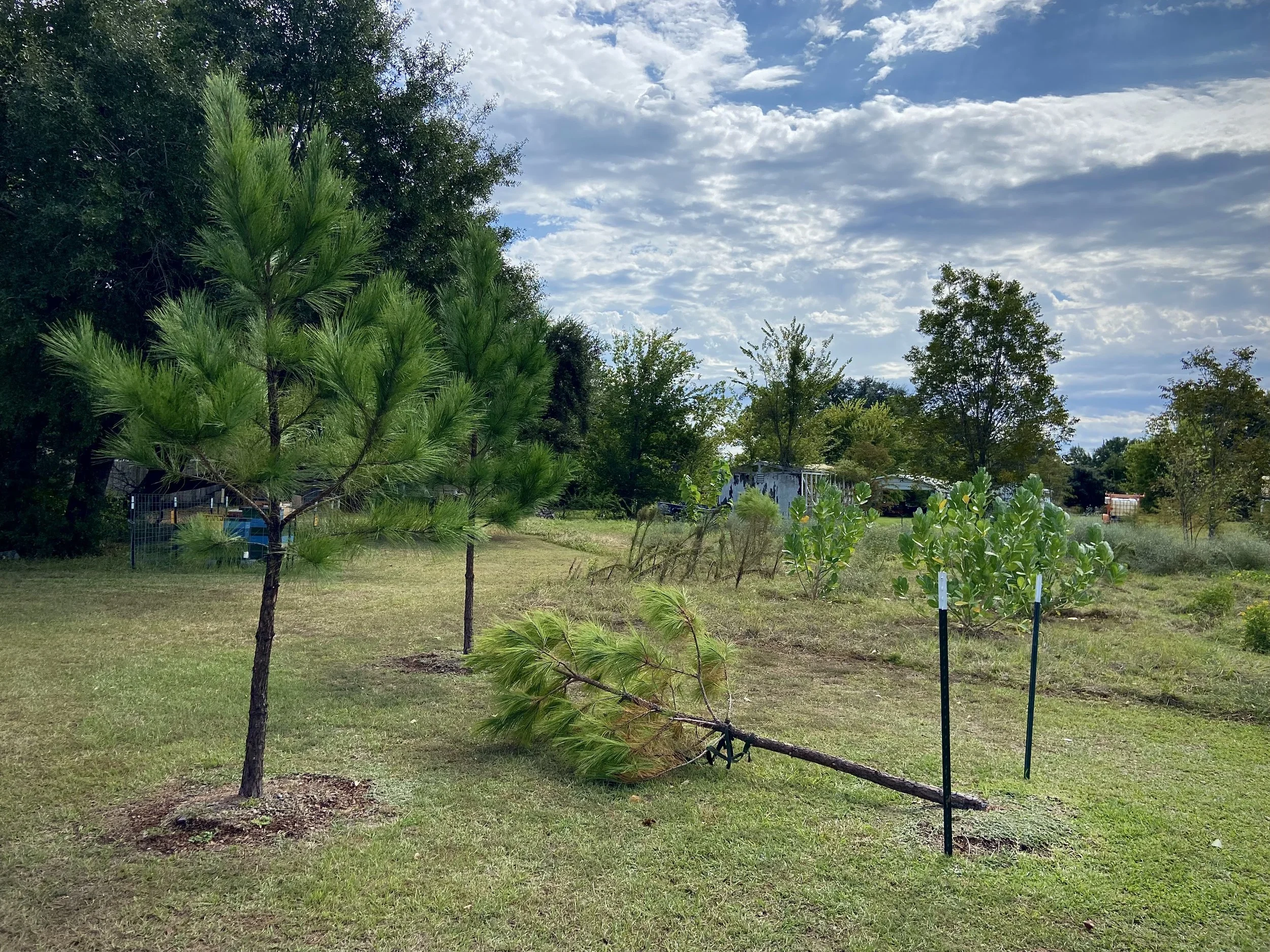What the Wind Revealed
The Breaking Point Between Dependence and Depth
By Josh Singleton | Founder and Lead Cultivator, The Neighborhood Garden Project
We planted these pines in February. Young, green, and full of promise, they stood in a line between the pocket prairie and the garden—each one meant to take root and grow tall over time. Through the spring and summer, I watched them stretch upward, their needles soft and bright, reaching for the sky.
But one never quite stood on its own. It leaned a little, always needing support. Stakes and straps held it steady through each gust of wind. At first, that seemed like care, but over time I noticed something at the soil line: the bark was wearing thin right where life met the ground. That’s where the strain lived, silent and unseen.
After each gust, I’d watch it twist more than the rest. The others flexed and rebounded, but this one resisted. The stress was concentrating right where trunk became root—the root collar.
The root collar is the narrow bridge between two worlds. Above it, the trunk is built to transport energy upward through vascular tissue that flexes with wind and growth. Below it, the roots are built to anchor and absorb, sending water and minerals toward the canopy. Between these two systems lies a thin transition zone where neither function is dominant—a biological hinge that must learn to bear both movement and stability.
When a tree remains staked too long or is watered only at the surface, its roots never develop the tensile strength needed to share that load. The result is a trunk that grows but never grounds. Every gust transfers mechanical stress into the root collar—where wood fibers twist, compress, and stretch until microscopic tears begin to form. Over time, these tears weaken the lignin, the woody polymer that gives structural strength.
From above, everything still looks healthy—green growth, soft needles, upward reach—but beneath the surface, small fractures widen. Moisture settles in those spaces, oxygen levels drop, and fungi begin their slow work of decay. By the time signs appear above ground, the separation has already begun below.
What I was watching wasn’t just a tree leaning. It was a conversation between wind and wood, between support and surrender. The wind wasn’t attacking—it was asking: Are you rooted yet, or still relying on what holds you up?
Sometimes, the very support meant to help a tree stand can keep it from fully taking root. It grows upright but not secure—steady for a season, but dependent beneath the surface.
Then the wind came.
It wasn’t a violent storm, just a steady, testing wind. By morning, the tree lay on its side—still green, still full of life, but severed at the soil level. The break wasn’t from above, where the straps once held it. It happened at the meeting place of strength and surrender—the soil line, where unseen pressure finally revealed what was lacking beneath.
The wind doesn’t come to destroy; it comes to reveal. It shows where pressure has built, where bark has thinned, where roots haven’t gone deep enough to carry what’s grown above. It doesn’t accuse—it clarifies.
Still, standing isn’t the only sign of life. For eight months, that tree did its job. It stood between the pocket prairie and the garden, gave shade, and reached upward with all it had. Though its time was brief, its purpose wasn’t wasted. Even short seasons matter when they serve their place in the story.
Now comes the work of salvaging what didn’t stand the test—to honor what tried, to return it to the soil that first gave it life, and to let its breaking become nourishment for what comes next. Nothing is wasted when it’s surrendered.
We’ll add what remains to our passive compost pile near the garden. Over time, it will break down, quietly returning to the rhythm of the earth. And one day, after decomposition has done its slow and holy work, what fell here between the pocket prairie and the garden will nourish new life.
The wind confirmed what I’d been sensing all along. The trunk didn’t fail—it revealed what was never firm. Moving forward, I’ll choose trees whose root collars have little to no give, those that resist twisting when the wind passes through. Because now I know: stakes and straps can’t make a tree strong—they can only buy it time. True strength comes from what’s formed in the soil, and the wind ensures that strength is tested, deepened, and ready to carry the life of the whole landscape forward.
And maybe that’s the deeper truth about the wind—it doesn’t just reveal weakness; it reveals what’s meant to carry us all forward. The same wind that tests a single tree also shapes the entire landscape. It clears weak branches, deepens roots, and circulates life across the ecosystem. Without testing, there’s no strengthening. Without pressure, there’s no balance. The earth itself depends on the rhythm of resistance to sustain its life.
The wind comes to test, but the soil teaches us how to begin again.

